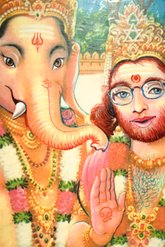
I didn't want to go too far into this exploration of Tswana culture and traditional medicine without mentioning snakes (for background information about my life in rural South Africa, please read the essay "About The South Africa Series" found along the right-hand side of this blog.) Snakes appear many times in this series of drawings, because they were often on people's minds and were the subject of endless conversation. In traditional Tswana culture, there are two types of snakes: "evil snakes" and "spirit snakes." Today's post deals with the first type.
Evil snakes can be touched and are of normal size. They exist in our realm of reality. This type of snake will be familiar to anyone who has read The Bible (in the New International version of The Bible, snakes are mentioned 22 times and serpents are mentioned 20 times)or has seen the towering cinematic achievement that is "Snakes on a Plane." Snakes, cats, dogs, baboons, owls, and bats are considered the handmaidens of witches and demons in Tswana culture, in same way that black cats accompany witches in European and North American representations of witches. A Tswana witch may also turn her/himself into any of these creatures at will (for more info on witches-see Sooth Africa #1.) But snakes generate a special kind of fear. Nothing will dampen high spirits like mentioning that you saw a snake on the way to the privy or while out collecting dried cow chips to make a fire.
While I was serving in the Peace Corps, I stayed in the compound(a fenced in piece of property containing several communal buildings)of the amazing Khorae Family. The block of rooms that I lived in was a relatively recent addition and had a concrete floor, but the main house had a traditional floor composed of compressed dung and sand. This foundation always seemed to be under attack by or playing host to one type of desert creature or another. I never saw them flinch when we removed the nest of giant sun spiders (Gross!) from the kitchen or poured boiling water to flush out the rats living under a bedroom. But, when we discovered a single small garter snake holed up in the corner of the common room one night, you would have thought we had discovered a hidden Bigfoot or tyrannosaurus. Screams. Running feet. Pots falling over to spill their contents on the floor. We all bent over the tiny body, beating the snake with anything hard that came to hand until its body had more bends than an aerobics class. I was caught up in the whole thing, whacking with my broomstick until it was a splintered mess. The clearly dead snake was then carried outside on the end of a long stick as if it would strike at any second. Once on the ground, it was doused in kerosene and set on fire. And, after the fire burned out, the snake's ashes were swept together into a little pile and burned again.
This fear extends to creatures thought to be related to snakes. Chameleons (sometimes called "snakes with feet") discovered near the family compound were treated in a similar manner. Once, during my first month in the village, I mentioned to my new friends that I had tasted rattlesnake and alligator meat at a barbecue in Chicago. Their reaction of disgust was so strong and immediate, that I might just as well have talked about snacking on human flesh. I never brought it up again. In my time in South Africa I never met anyone who claimed to have been bitten or harmed by a snake (though large pythons do exist in some areas), but everyone seemed to have a story about a close encounter or a near miss. Every person or society has fears that seem strange to outsiders. The many seemingly unexplained deaths due to AIDS, have caused traditional beliefs that were seen as laughable 15 or 20 years ago to rise to the surface. If you think back to the panicked rumors that swirled in the days and weeks following the 9/11 attacks, then you will get a taste of the type of fear and confusion that is building today in parts of Southern Africa. Today's drawing features the second type of snake often talked about: the spirit snake. Next time: I will tell you about spirit snakes and their relationship to traditional healers.



No comments:
Post a Comment